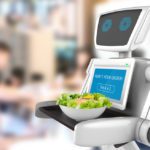Restaurant labor costs are big problem for restaurants of all types and sizes and with competition for good employees, labor regulations, minimum wage bumps and healthcare costs, they’ll continue to keep increasing. But it is possible to source restaurant equipment at a reasonable price if you look at things like globe slicer parts.
According to the National Restaurant Association, in 2016 sales per employee averaged $58,000. Compare that to the grocery industry that averages $232,000 in sales per employee.
That tells us that restaurants are four times less efficient when it comes to labor. In fact, the Bureau of Labor and Statistics reports that restaurant labor productivity has remained flat for the past ten years. There is a real need to utilize the budget in other ways, such as using an inbound marketing agency. Perhaps this could even be an Inbound Marketing Agency London and Hubspot Platinum Partner. Consequentially, money needs to be saved from somewhere.
But with recent technological developments, you can now improve productivity and reduce restaurant labor costs. Here are three main technologies that can drive rapid improvements for restaurant chains of most every size and type.
- Food Safety Automation

Chef @ Sanuu / Disney Animal Kingdom. Friday, September 7th, 2012
Restaurants are looking at the labor intensive, time-consuming process of food safety audits and compliance and trying to find ways to streamline it, make it more efficient and most importantly, cost less labor-wise. New technologies on the market like Disney CHEFS® tackle this head on with ways to reduce the amount of time your employees and managers spend dedicated to food safety. These technologies help by:
- Automating food procedures
- Eliminating paper checklists
- Monitoring food digitally
Implementing this type of solution could change the entire way your kitchen handles food safety and help you control your restaurant labor costs in a way you never thought of before, by reducing the amount of time dedicated to food safety.
- Kitchen Display Systems

Using kitchen display systems (KDS) in your back of the house (BOH) operations makes sense from an efficiency standpoint. That efficiency pays off in reduced labor costs when you can make each area work faster and handle a higher volume.
KDS allows you to route specific tickets to different stations, to color code orders, track ticket times and, to many restaurant employee and owners’ delight, get rid of paper. They allow you to fulfill more orders in the same amount of time and improve communications with the front of the house (FOH). Another benefit that more restaurants don’t think about initially is that the KDS can be integrated with online ordering so when orders are placed, they go directly to the kitchen without having to go through an order taker to put them into the system.
- Self Service Kiosks

While food safety automation and kitchen display systems focus on the BOH for reducing labor costs, self-service kiosks take aim at FOH restaurant labor costs. Customers like them because they shorten lines during peak periods and give them complete power to customize their orders. Much like how the airline industry has used self-service check-in kiosks to improve customer service, the restaurant industry is also using kiosks to shorten wait times and improve order accuracy. Employees are still on hand to greet and assist customers but in less numbers than would be needed to open another register.
Reducing Your Restaurant Labor Costs is Possible
Taking a hard look at your labor costs and identifying areas you can make more efficient and where you can make reductions is going to be a much easier endeavor if you employ the help of technologies built to make your employees more productive. Consider adding food safety automation, kitchen display systems or even self-service kiosks if it makes sense for your restaurant. With costs on the rise, it might be a great investment to help you ultimately decrease your restaurant’s labor costs.
Mainstreet at MUFSO
Mainstreet recently co-sponsored the Nation’s Restaurant News (NRN) Multi Unit Food Service Operator (MUFSO) restaurant conference in Dallas. The 58th annual event was well attended by operators from businesses ranging from independent restaurants to large national chains.
We were honored to be a co-sponsor along with other industry suppliers and NRN’s team of journalists did a great job of reporting on all sessions and events, including 5 major takeaways.
What’s been your experience with handling rising restaurant labor costs? Have you got them under control or would you like to learn more about some technology solutions that can help you do just that? We’d like to hear from you.

